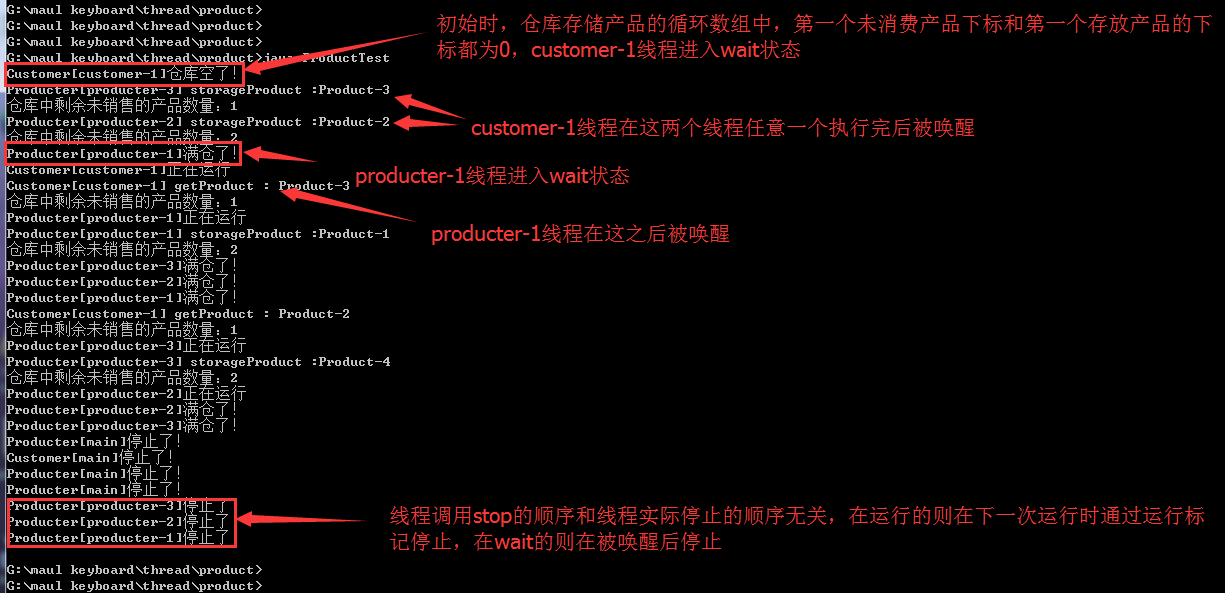多线程协作-生产者和消费者
public class Product{ private String name; public Product(String name){ this.name = name; } //重写了Product类的toString方法,自定义Product类的Feild展示为字符串的格式 public String toString(){ return "Product-"+this.name; } }
import java.lang.Thread; //采用默认的default访问控制符,仅限当前类的同一个包中类访问 class Producter extends Thread{ //生产者生产产品,需要放入仓库,还需要区分生产的产品 private WareHouse wareHouse ; private static int productName ; //线程是否运行标记 private boolean running = false; public Producter(WareHouse wareHouse, String producterNmae){ //继承Thread的构造函数,也就继承了Thread对象的功能 super(producterNmae); this.wareHouse = wareHouse; } public void start(){ this.running = true; super.start(); } public void run(){ Product product; try{ while(this.running){ //(int类型的productName)+(""),合并的结果为String类型 product = new Product((++productName)+""); this.wareHouse.storageProduct(product); //等待wait状态的线程执行完synchronized代码块,当前线程再释放对象锁 //主要是为了暂停当前线程,把cpu片段让出给其他线程,减缓当前线程的执行 Thread.sleep(10); } }catch(InterruptedException e){ e.printStackTrace(); } } //将当前生产者线程停止 public void stopProduct(){ //线程同步的资源对象是仓库 synchronized (wareHouse){ this.running = false; System.out.println("Producter["+Thread.currentThread().getName()+"]停止了!"); //将所有等待WareHouse对象的线程唤醒,告知当前线程停止 this.wareHouse.notifyAll(); // this.wareHouse.notify(); } } public boolean isRunning(){ return this.running; } }
import java.lang.Thread; //采用默认的default访问控制符,仅限当前类的同一个包中类访问 class Customer extends Thread{ private WareHouse wareHouse; private boolean running = false ; public Customer(WareHouse wareHouse, String customerName){ super(customerName); this.wareHouse = wareHouse ; } public void start(){ this.running = true ; super.start(); } public void run(){ try{ while(this.running){ this.wareHouse.getProduct(); Thread.sleep(1000); } }catch(InterruptedException e){ e.printStackTrace(); } } public void stopCustomer(){ synchronized(this.wareHouse){ this.running = false ; System.out.println("Customer["+Thread.currentThread().getName()+"]停止了!"); //将所有等待WareHouse对象的线程唤醒,告知当前线程停止 this.wareHouse.notifyAll(); // this.wareHouse.notify(); } } public boolean isRunning(){ return this.running; } }
import java.lang.Thread; //采用默认的default访问控制符,仅限当前类的同一个包中类访问 class WareHouse{ //默认仓库容量 private static int CAPACITY = 11 ; //存放产品的循环数组,生产的新产品紧跟现有产品后存放,消费的产品从现有产品首个开始获取 private Product[] products; private int front = 0 ; //仓库中第一个未消费产品下标 private int rear = 0 ; //仓库中最后一个未消费产品下标 public WareHouse(){ this.products = new Product[CAPACITY]; } public WareHouse(int capacity){ //初始还是默认仓库容量 this(); if(capacity > 0){ CAPACITY = capacity + 1 ; this.products = new Product[CAPACITY]; } } public void storageProduct(Product product){ synchronized(this){ boolean producerRunning = true ; Thread currentThread = Thread.currentThread(); if(currentThread instanceof Producter){ producerRunning = ((Producter)currentThread).isRunning(); }else{return;} //保留最后一个可以存储的位置并等待销售唤醒,唤醒后如果还需要生产,但仅剩最后一个可以存储的位置则循环等待 while(((rear+1) % CAPACITY) == front && producerRunning){ System.out.println("Producter["+currentThread.getName()+"]满仓了!"); try{ this.wait(); }catch(InterruptedException e){ e.printStackTrace(); } //唤醒后该生产者是否还需要生产 producerRunning = ((Producter)currentThread).isRunning(); System.out.println("Producter["+Thread.currentThread().getName()+"]"+ (producerRunning==true ? "正在运行":"停止了")); } //该生产者不需要生产,则结束 if(!producerRunning){return;} this.products[rear] = product ; System.out.println("Producter["+currentThread.getName()+"] storageProduct :"+product.toString()); //下一待存储下标循环下移 rear = (rear + 1) % CAPACITY; System.out.println("仓库中剩余未销售的产品数量:"+(rear+CAPACITY-front) % CAPACITY); //随机唤醒等待仓库资源对象的一个线程,包括生产者线程和消费者线程 this.notify(); } } public Product getProduct(){ synchronized(this){ boolean customerRunning = false ; Thread customerThread = Thread.currentThread(); if(customerThread instanceof Customer){ customerRunning = ((Customer)customerThread).isRunning(); }else{return null;} while(front==rear && customerRunning){ System.out.println("Customer["+customerThread.getName()+"]仓库空了!"); try{ this.wait(); }catch(InterruptedException e){ e.printStackTrace(); } customerRunning = ((Customer)customerThread).isRunning(); System.out.println("Customer["+Thread.currentThread().getName()+"]"+ (customerRunning==true ? "正在运行":"停止了")); } if(!customerRunning){return null;} Product product = this.products[front]; System.out.println("Customer["+customerThread.getName()+"] getProduct : "+product.toString()); //下移待销售下标循环下移 front = (front + 1 + CAPACITY) % CAPACITY; System.out.println("仓库中剩余未销售的产品数量:"+(rear+CAPACITY-front) % CAPACITY); //随机唤醒等待仓库资源对象的一个线程,包括生产者线程和消费者线程 this.notify(); return product; } } }
import java.lang.Thread; public class ProductTest{ public static void main(String[] args){ WareHouse wareHouse = new WareHouse(2); Producter producter1 = new Producter(wareHouse, "producter-1"); Producter producter2 = new Producter(wareHouse, "producter-2"); Producter producter3 = new Producter(wareHouse, "producter-3"); Customer customer1 = new Customer(wareHouse, "customer-1"); Customer customer2 = new Customer(wareHouse, "customer-2"); Customer customer3 = new Customer(wareHouse, "customer-3"); Customer customer4 = new Customer(wareHouse, "customer-4"); // producter1.start(); // producter2.start(); // producter3.start(); // customer1.start(); // customer2.start(); // customer3.start(); // customer4.start(); producter1.start(); customer1.start(); producter2.start(); // customer2.start(); producter3.start(); // customer3.start(); // customer4.start(); try{ Thread.sleep(1600); }catch(InterruptedException e){ e.printStackTrace(); } // producter1.stopProduct(); // producter2.stopProduct(); // producter3.stopProduct(); // customer1.stopCustomer(); // customer2.stopCustomer(); // customer3.stopCustomer(); // customer4.stopCustomer(); producter1.stopProduct(); customer1.stopCustomer(); producter2.stopProduct(); // customer2.stopCustomer(); producter3.stopProduct(); // customer3.stopCustomer(); // customer4.stopCustomer(); } }
运行结果:




